Living in rural Minnesota has given me access to a wide range of spruce trees. In early Spring the tender tips can be harvested and made into teas, infused sugars, syrups and even baked goods!
Check out this guide to harvesting and using spruce tips in delicious, creative ways.
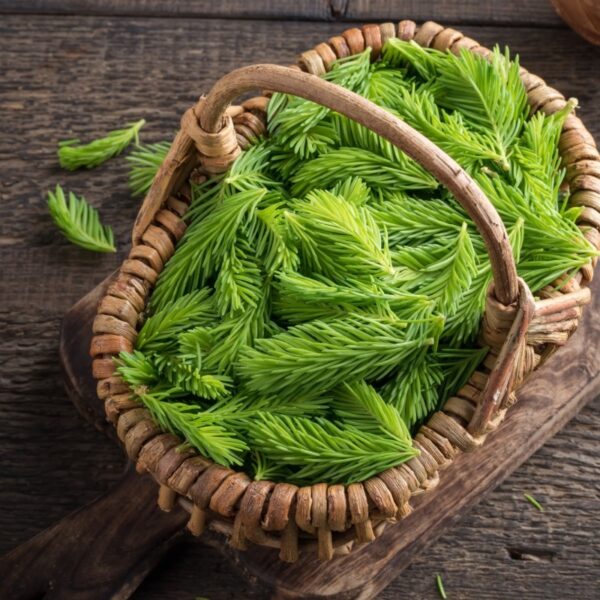
Jump to: RECIPE: Spruce Tip Tea | What Exactly Are Spruce Tips? | How to Harvest Spruce Tips | 10 Delicious Ways To Use Spruce Tips | Frequently Asked Questions
This post may contain affiliate links. As an Amazon Associate, I also earn from qualifying purchases. You can read our disclosure information here–
What Are Spruce Tips?
Readers from Alaska and other northern states, as well as Canada and Nordic countries may already be well aware of what spruce tips are and some ways to use them, but let’s do a quick rundown for the rest of us.
If you love foraging your own food, this is definitely an edible to look out for.
Spruce tips are the young tips of any species of spruce tree (genus Picea). This new growth is a lighter green in color and softer than older needles. It appears in springtime, and yes, it’s edible!
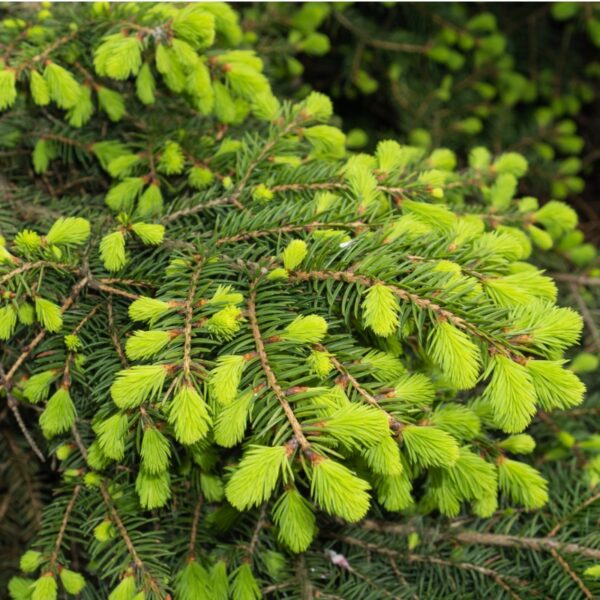
Spruce tips actually used to be a staple here in the US and particularly in Canada. They’re easy to find, taste nice, and are brimming with vitamin C.
Indigenous Alaskan populations have been using spruce tips for thousands of years, as they’re a great way to fight off scurvy during times when other sources of vitamin C are scarce.
Famously, French explorers in Canada learned from natives how to make spruce needle tea and get rid of the scurvy plaguing their ranks. Spruce tip beer was also popular, with the tips being used during the brewing process in place of hops.
In terms of flavor, spruce tips are generally lightly citrusy and tart, with warm resin and pine notes. They taste foresty and fresh.
Tip: Keep in mind that spruce tip flavor depends a lot on the species of tree. If you can, I highly recommend just trying a bunch of different ones and seeing which you prefer! Some may be too tart or bitter for your taste.
What About Pine Tips and Other Conifer Tips?
When it comes to edible conifer tips, the focus tends to be squarely on spruces. The good news for those who only have access to pines or firs is that these are also edible, but with a slight different flavor.
There is however, one conifer that is not edible: yew trees from the genus Taxus, which are poisonous (but luckily, also easy enough to recognize). Please see the comparison picture below so you know what to avoid.
The most obvious thing about a yew will be its red berries, which none of the edible conifers have.
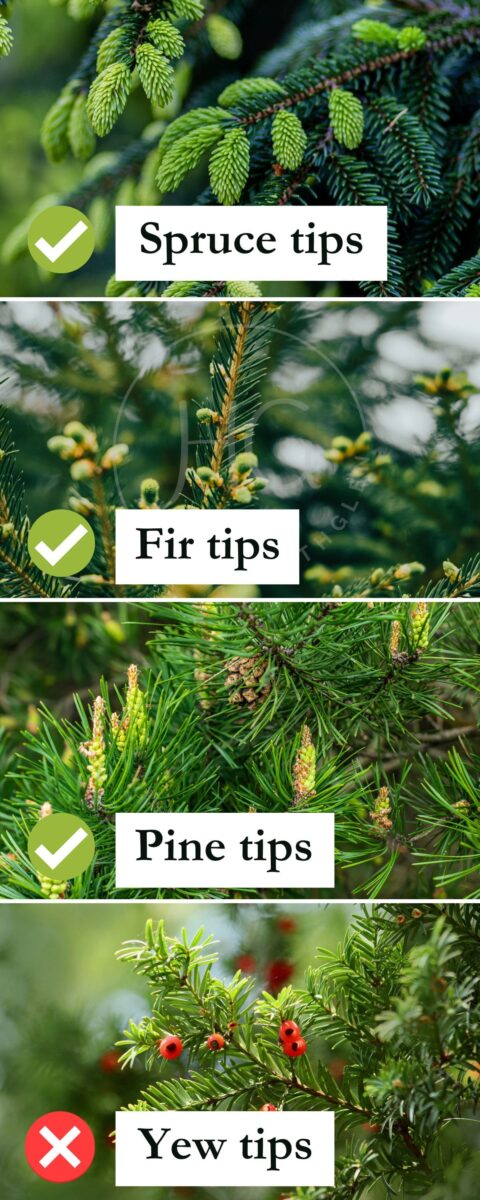
Harvesting or Foraging Your Own Spruce Tips
If you’d like to give harvesting spruce tips a shot, the good news is that it’s easy. The most important thing to keep in mind is that you’re after the young, green shoots that appear in spring.
You’ll want them to be quite compact still; it’s fine if they still have their papery husk, which can be removed later.
You can technically eat older conifer needles, and they’re sometimes used for tea, but they’re quite astringent and the flavor won’t be nearly as good.
Here’s what you need to look out for while foraging:
- Choose trees that are away from roads or that may have come into contact with pesticides or other toxins.
- Choose healthy, mature trees. Leave the younger ones to grow for a bit longer.
- Don’t pick the tip off a conifer, as this can cause it to grow wonky.
- Don’t pick too much from each tree. Removing a maximum of 25% of the tips ensures it’ll be able to continue growing healthily.
If you’re trying spruce tips for the first time, picking a cupful or two will probably be enough. You’ll get a good bit of tea or other uses out of this, as they are fairlly strong and a little goes a long way.
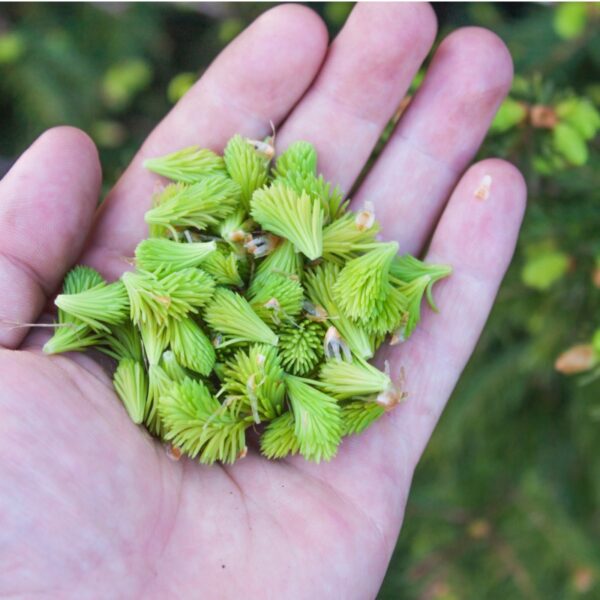
How Long will They Last?
Your spruce tips will last for weeks in the fridge, so there’s no rush when it comes to using them. If you’re still worried they will go off, they can also be dried for tea or even frozen (although the latter does affect their texture).
Did you know? Young, unopened pinecones are also edible. In some countries, they’re traditionally used to make syrups and jams.
10 Tasty ways to use spruce tips
1. Spruce Tip Syrup
Move over maple syrup! Spruce tip syrup is easy to make once you’ve obtained your spruce tips, and it goes well with a variety of recipes. Cocktails, cheese platters and pancakes all love that pine aroma!
There’s a quick and a slow way to make spruce tip syrup, with the slow method being more traditional and the result more intense.
The quick way is a standard syrup recipe: bring sugar and water to a boil, then stir in the flavorings (spruce tips, in this case). Let cool, strain and voilà!
If you’re not in a rush, you can mix the sugar and spruce tips first and then leave the whole thing to macerate in a jar for a month, as described by Forager Chef. Then, after the flavors have had plenty of time to mingle, you boil and strain the resulting mixture to make your syrup.

2. Spruce Tip Jelly
Although my favorite homemade jelly from “foraged” ingredients is this recipe for dandelion jelly, spruce tips make for a pretty good runner-up.
The bright and citrusy resin flavors imparted by the spruce tips are something you really don’t get with any other ingredient. And what a unique addition to a cheese tray!
Making jellies is easy, and the basic method is pretty much always the same. You first make an infusion using your herb or spice of choice (the spruce tips, in this case), as if you were making a strong tea. Then, you mix the resulting spruce tip water with lemon juice, sugar and pectin to make a jelly.
If you’re planning to use the jelly soon, you can pour it into a jar and refrigerate (known as freezer jam). To be able to store it for a longer time, you will need to process it in a water bath canner.
Directions for processing in a water bath can be found on this post for dandelion jelly.
3. Pickled Spruce Tips
Yes, you really can pickle just about anything! Pickled spruce tips go well with things like fish (they’re fantastic with smoked salmon), various soups, salads and even martinis or a nice Bloody Mary.
The flavor of pickled spruce tips has been described as similar to capers, though with a distinct burst of lemony aroma.
As with jellies, the basic recipe for pickles is always pretty much the same. The only difference is that I personally like my pickled conifer tips without any sugar.
Other than that, you can just follow my other pickling recipes, like this one for green tomatoes, if you’d like to try them.
4. Spruce Tip Infused Sugar
You may have heard of something like lavender sugar – perfect for sugar cookies – but did you know you can easily make all sorts of flavored sugars at home?
Spruce tip sugar is a fantastic example. It’s foresty and citrusy, making it a fantastic addition to all sorts of baked goods and cocktails. Heck, it even works well as a refreshing body scrub!
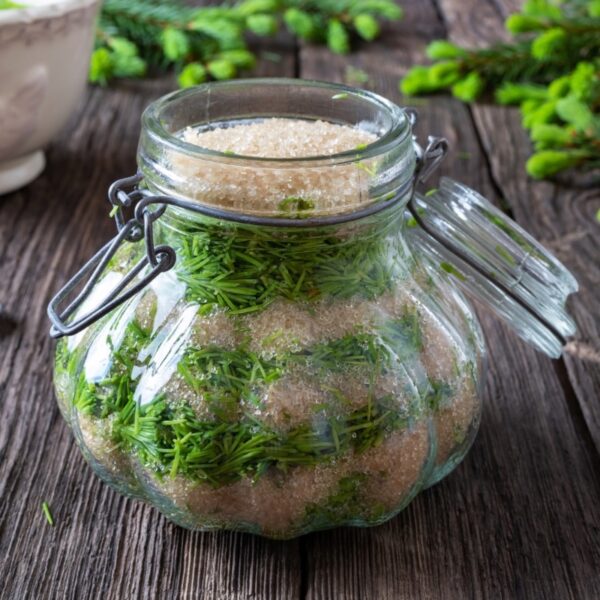
To make spruce-flavored sugar, all you have to do is combine equal amounts of sugar and spruce tips in a food processor. Pulse until the spruce tips have broken down to release their flavor, but don’t overdo it or you’ll end up with powdered sugar.
The resulting mixture will be a little wet, so the next step is to dry it. The quickest way to do this is to spread it on a baking sheet and pop it in the oven on low (around 200 °F) until dry.
5. Spruce Tip Salt
You may have seen this one coming. Yes, you can make spruce tip salt just as easily as spruce tip sugar! The method is identical: combine equal amounts of salt and spruce tips in a food processor, then dry the end result and store it. It will last pretty much indefinitely.
Making herbal salts with your Summer herbs is a good way of preserving herbs and can be used in Winter blended with the spruce tip salt.
You can use your spruce tip salt for all sorts of savory dishes. It works well as a meat rub and for fish in particular. Smoked salmon and spruce salt omelet, anyone?
6. Candied Spruce Tips
If you’re in need of a garnish for cakes and other baked goods, think beyond just spruce tip sugar. One option that’s sure to get you some oohs and aahs is candied spruce tips, which are sugary and sweet but retain that typical spruce tip flavor.
Making candied spruce tips is a great option if you’re already making spruce tip syrup (scroll back up to #1 if you haven’t checked that idea out yet). However, they can technically be prepared using any simple syrup.
If you use a plain simple syrup, the spruce tips will infuse it with a light spruce flavor.
All you have to do is bring the sugar and water you’re using for your syrup to a boil, add the spruce tips and then simmer for five minutes.
Let the whole thing cool, fish out the spruce tips and lay them out on a baking sheet. Pop in the oven at around 100 °F until the tips are dry, which can take a few hours. And that’s it!
7. Spruce Tip Soda
If you like a refreshing and citrusy carbonated drink, you’ll love spruce tip soda. Perfect for summer, and it’s easy to make too.
The simplest way to do it is to mix spruce tip syrup (see #1 on the list) with some sparkling water and maybe a dash of lemon or lime juice.
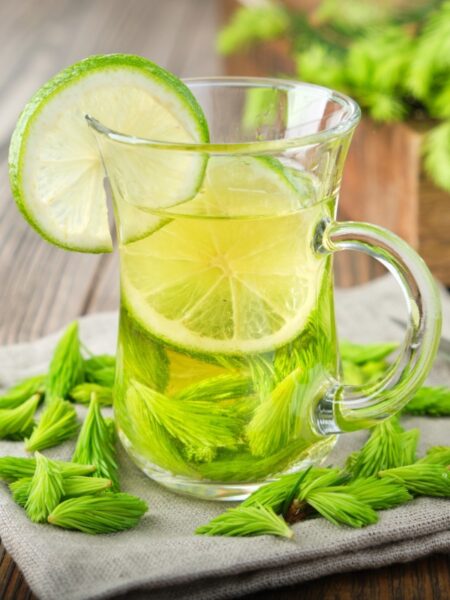
If you take drinks seriously, you can also consider trying your hand at a homemade fermented soda.
Just place water, sugar, spruce tips and a yeast starter in a big, clean jug and leaving it out on the counter for up to 48 hours will produce a naturally carbonated drink with deeper flavors than the basic syrup option. Wildness has a good description of the basic method if you’d like to give it a try!
8. Spruce Tip IPA
Readers who are into craft beers may have tried a spruce tip beer before. Spruce tip IPA is particularly popular, and that’s not surprising, as it makes for a wonderfully balanced beer with woodsy pine and citrus notes.
Spruce is actually quite similar to hops in terms of its flavor profile, and it can be used in pretty much the same way.
The casual beer enthusiast can buy spruce tip IPA in various places. If you’re into brewing your own, though, that’s also definitely an option!
As described over at Brülosophy, you can add the spruce while boiling or during fermentation.
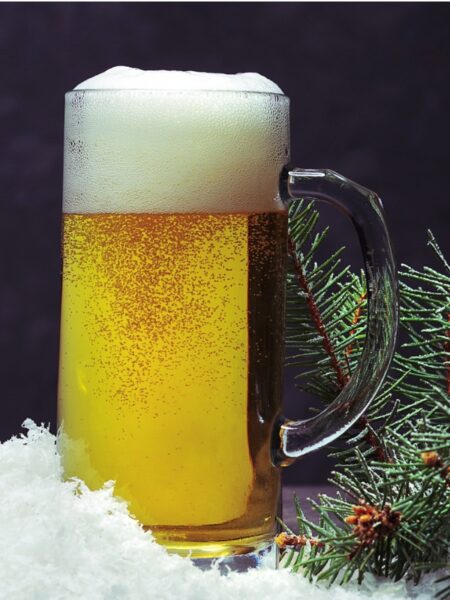
9. Spruce Tip Cake
As we’ve discovered, spruce tips have a bunch of uses in baking, especially as a garnish in the form of spruce tip sugar or candied spruce tips. Sponge cake moistened with spruce tip syrup is also rather heavenly.
If you’d like to take things even further, another option is to use spruce tips directly in the cake batter.
You can use the spruce tips strained from a batch of spruce tip syrup for this, or you can chop up some fresh ones in a food processor to fold into the batter. Nordic forest flavors guaranteed.
10. Spruce Tip Ice Cream
Since it’s high summer as I’m writing this and I would love a good scoop of gelato right now, it seems only appropriate to mention that spruce tip ice cream exists, and you can make it at home just like any other ice cream.
You just need an ice cream maker, which is a useful kitchen appliance to invest in if you love sweet treats.
For a subtle spruce flavor, you can infuse chopped spruce tips in the heavy cream and milk you’ll be using for the ice cream overnight. To make an ice cream that really screams “forest!”, though, it’s best to blend the whole thing together until the spruce tips are pretty much gone.
Once blended, pass the mixture through a fine strainer, before finishing the recipe as you would do with any ice cream.
11. Spruce Tip Tea Recipe
I can’t finish up an article about using spruce tips without mentioning spruce tip tea! After all, I am a tea lover and a tea seller!
I don’t have spruce tip tea for sale primarily because I haven’t been able to harvest enough tips to go beyond family and friends. Perhaps next year. The closest loose tea I offer for purchase would be the green tea and pomegranate.
If you have access to spruce tips however, it is very easy to make a homemade tea (see recipe below).
Just let the tips steep in hot water, tasting frequently to see how strong you prefer it. As with many teas, steeping it for too long can make it bitter.
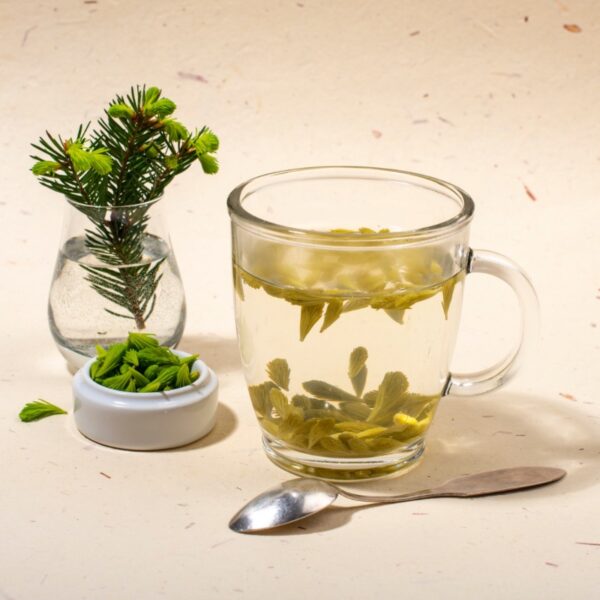
You can make spruce tip tea with fresh spruce tips, but you can also use dried ones, which comes in handy since this foraged delicacy isn’t available year-round.
Spruce tip tea has loads of vitamin C and tastes wonderful, especially if you pair the spruce tips with their best friends: lime and honey.
The tips do last for ages if you refrigerate them, and they can also be frozen, but dried ones are just very convenient for tea.
If you want to dry your spruce tip harvest, just use a dehydrator or pop them in the oven for about 6 hours at 100 °F (or until dry).
If you like my articles about cooking and gardening, subscribe to my weekly newsletter, where I share free recipes and gardening tutorials.
Spruce Tip Tea
Equipment
- 1 Tea pot
- 1 Tea strainer if your teapot doesn't have a built in strainer
Ingredients
- ¼ cup spruce tips per cup of water
- water enough to fill your teapot
- 2 slices lime optional; according to taste
- 1 tbsp honey optional; according to taste
Instructions
- Boil the water while you place the spruce tips and optional additives in the teapot. If your teapot has an infuser, put the tips in there.1/4 cup spruce tips
- Pour the hot water into the teapot and let steep for around 10 minutes.water
- Take out the infuser with the spruce tips or strain the tea through a tea strainer. Serve hot or over ice. Enjoy!2 slices lime, 1 tbsp honey
Notes
- As discussed in the post, any type of conifer except yew is edible. The flavor varies a good bit, though, so just try some different ones.
- Other good add-ins for this tea include mint, a cinnamon stick, and homemade spruce syrup.
- Please don’t consume spruce tip tea if you’re pregnant. Like some other plants that can otherwise be consumed safely, it can work as an abortifacient and induce miscarriage.
Nutrition
Frequently asked questions
If you don’t have any spruce trees nearby, fear not. You can also buy spruce tips! Some Canadian and Alaskan companies sell dried spruce tips, and you may even be able to order fresh ones in some places during the spring season.
Sure are. They’re a great source of vitamin C and actually used to be quite popular for fighting off scurvy. And although it won’t make a cold go away, some spruce tip tea with honey definitely helps soothe an achy throat!
Drying your spruce tips is very easy. If you have a dehydrator, that should work perfectly. If you don’t, you can just spread the tips on a parchment-lined baking sheet and place them in the oven at around 100 °F until completely dry. Keep the oven door cracked so the moisture can escape. 6 hours should usually do it, but your mileage may vary according to your local climate and the size of your spruce tips.


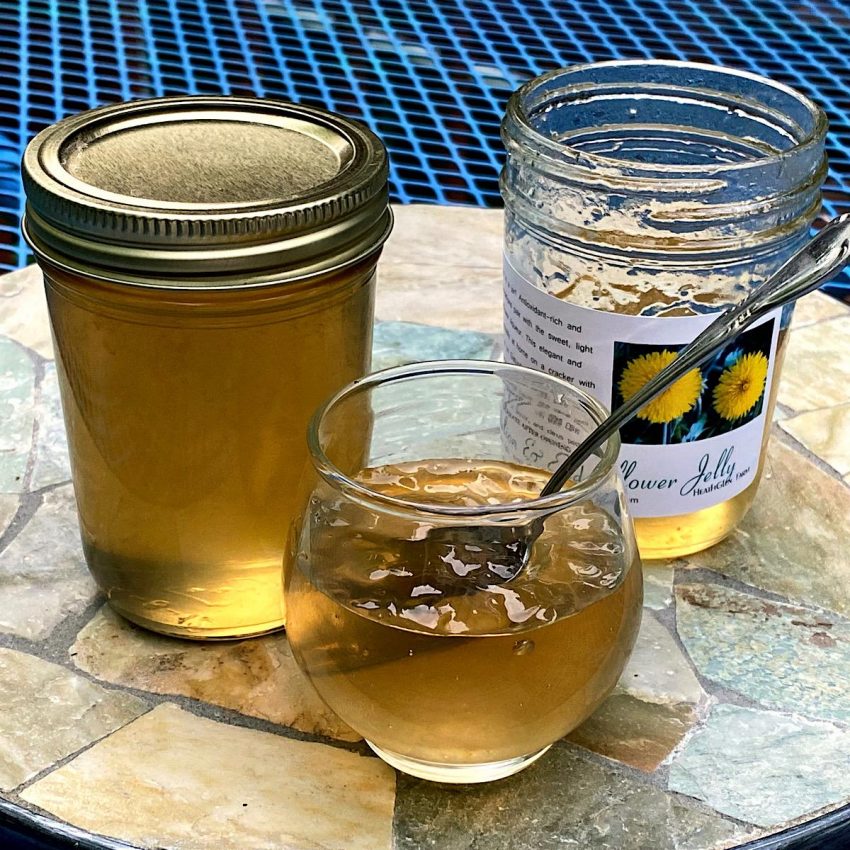
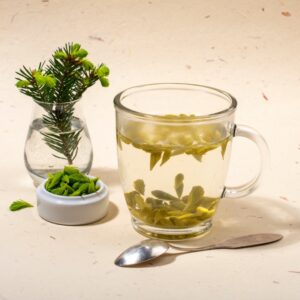
Leave a comment